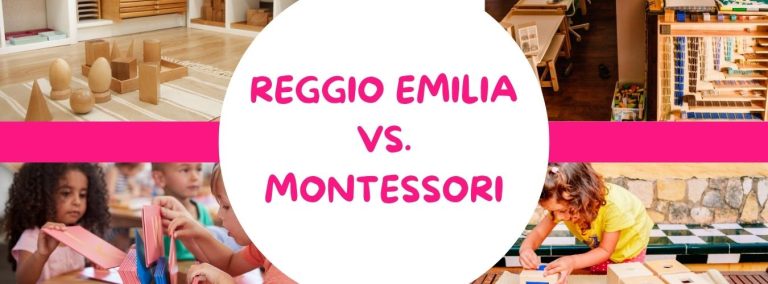9 Best Montessori Tummy Time Toys

Tummy time is an important daily activity for babies that promotes healthy development. Choosing the right toys during tummy time can maximize your baby’s experience. Montessori tummy time toys are one of the best options out there. In this post, we’ll explore the benefits of using Montessori-inspired toys to create engaging and educational tummy time sessions.
What is Tummy Time?
Tummy time refers to any time babies spend on their stomachs while awake and supervised. This includes laying on a blanket or play mat as well as tummy-to-tummy time on a parent’s chest. Tummy time offers many physical and developmental benefits for infants.

Why Use Montessori Tummy Time Toys?
Montessori toys are designed to stimulate the senses and encourage exploration. Using thoughtfully designed toys during tummy time enhances your baby’s learning, coordination, and motor skills development.
9 Montessori Tummy Time Toys
These Montessori toys provide multi-sensory experiences through sights, sounds, and textures. They allow for open-ended, self-directed play that develops visual tracking, listening skills, coordination, and cognitive abilities. Each toy offers novel ways for babies to actively explore their environment and understand cause-and-effect relationships. Montessori tummy time toys keep babies engaged while promoting crucial developmental milestones.
1. Pocket Panda Baby Mirror Toy for Tummy Time
2. The Play Gym by Lovevery Stage-Based Developmental Activity Gym
3. Infantino 2-in-1 Tummy Time & Seated Support
4. Soft Tummy Time Book with Large Stimulating Baby Safe Mirror
5. 3-in-1 Tummy Time Mirror Toys with Soft Crinkle 3D Activity Book
6. Baby Einstein 4-in-1 Kickin’ Tunes Music and Language Play Gym and Piano Tummy Time Activity Mat
7. Double-Sided Tummy Time Floor Mirror
8. Baby Mirror Tummy Time with High Contrast Soft Baby Crinkle Book
9. Taf Toys Koala Infant Tummy Time High Contrast Soft Crinkle Activity Book
Montessori Tummy Time Product Gallery

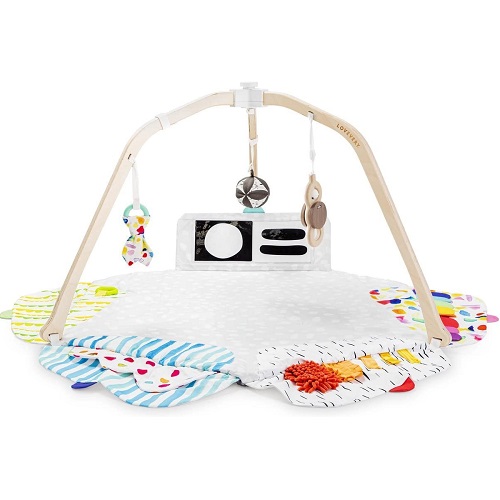
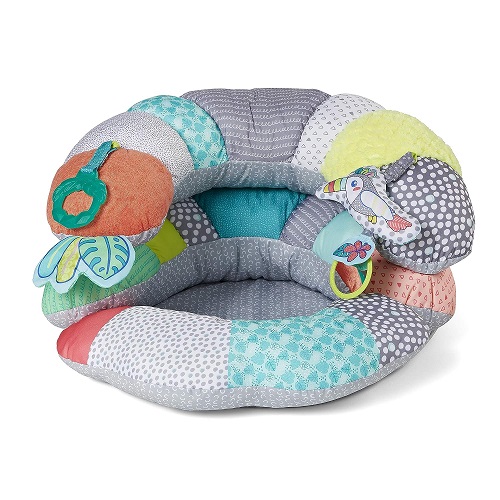

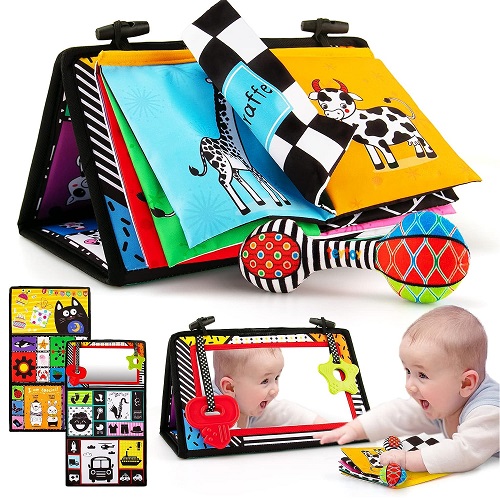


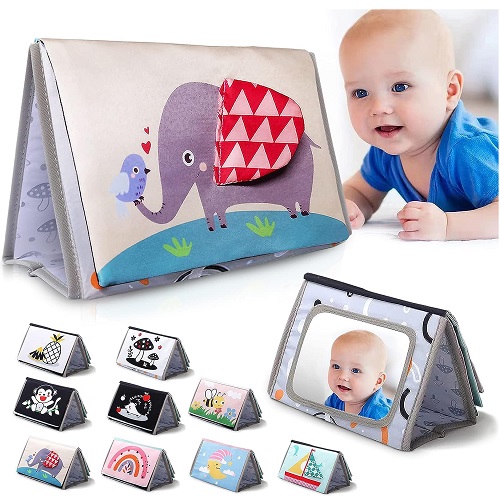
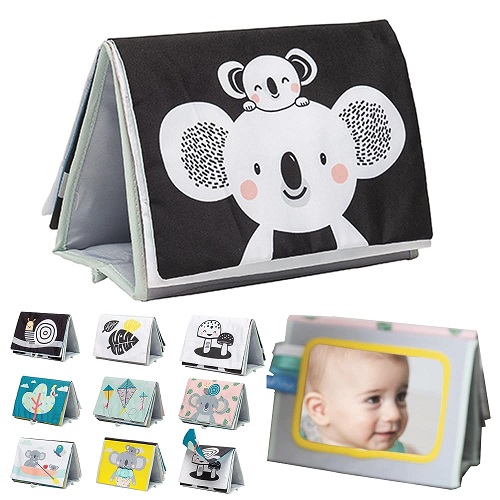
How to Do Tummy Time Effectively
Tummy time involves babies laying on their stomachs while awake, with their upper body weight supported on their forearms, hands, and chest. It’s recommended babies have daily tummy time starting as early as the first week of life. Tummy time is important because it strengthens the neck, arms, and core muscles. It also improves motor skills, prevents flat spots on the head, and allows babies to practice skills needed for crawling, sitting up, and walking.

Tummy Time Helps Strength and Muscle Development
The main muscles exercised during tummy time are located in the neck, arms, and trunk. Pushing up on straightened arms strengthens chest and arm muscles. Keeping the head and neck lifted builds up neck muscles. Core muscles get a workout too from holding the back and neck aligned. As these muscles strengthen, babies gain the stability and coordination needed to start rolling over, sitting, and crawling. Tummy time also prevents flat spots on the head’s soft areas. Varying head position during waking hours allows for evenly distributed pressure across the skull as it develops.
4 Benefits of Montessori Tummy Time Toys
While there are many benefits to tummy time, we listed 3 of the major benefits that babies will get below.
1. Babies Will Enjoy Tummy Time with Montessori Toys
Montessori tummy time toys are designed to be visually and tactilely stimulating for babies without being overbearing. They tend to feature contrasting colors, patterns, textures, sounds, and shapes that capture babies’ attention and curiosity. The toys encourage reaching, grasping, pushing, pulling, and more. All of these actions promote fine and gross motor development. Since the toys are developmentally appropriate, babies can actively participate and learn through self-directed play.

2. Montessori Tummy Time Toys Help With Exploration and Cognitive Development
During self-directed play, babies decide which activities and toys to interact with based on their interests. Montessori toys allow for open-ended exploration that engages multiple senses and abilities. Tactile features let babies feel different textures and materials. Visual components like high-contrast patterns provide a focus for babies’ developing eyesight.
3. Babies Can Improve Sensory Skills and Motor Skills
Auditory qualities like crinkly paper or bells offer meaningful sounds to interpret. As babies explore these captivating toys, they build cognitive, sensory, motor, and problem-solving skills. Tummy time offers the ideal position for hands-on play with these educational toys.
4. Tummy Time is a Great Way to Bond With Your Baby
Tummy time doesn’t have to be mere exercise; it’s a chance to playfully bond with your baby! Find toys that capture your little one’s curiosity and give them room to discover their capabilities. Rotate different options to keep it exciting. Choose toys that grow with your baby to continue presenting challenges. With safe, supervised tummy time and toys to match each stage, babies thrive physically and developmentally while having fun with mom or dad.

5 Tummy Time Guidelines
1. Start Early
The American Academy of Pediatrics recommends introducing daily tummy time as early as the first week of life. Start with just 1-2 minutes once or twice a day. Slowly increase tummy time duration as your baby shows enjoyment and head control. By around 3 months, aim for longer sessions totaling around 30-60 minutes of tummy time throughout the day. Break up tummy time into short but frequent sessions based on your baby’s tolerance.
2. Increase Tummy Time As Baby Grows
As your baby gets used to tummy time and gains strength, slowly make sessions longer. Watch for cues that it’s time to end tummy time, like fussiness, tiredness, or turning the head to the side. Increase time on their tummy by just a minute or two each day. You can also make play more engaging by incorporating toys and interacting with your baby during sessions. With consistency, work up to doing tummy time for at least a total of 30-60 minutes daily by around 3 months old.
3. Create a Safe Tummy Time Environment
Always supervise tummy time in a safe area free of suffocation hazards. Choose a flat, firm surface like the floor, play mat or blanket. Avoid soft, uneven surfaces that could make breathing difficult if the face presses into them. Use an infant play mat or blanket for padding and traction. Make sure the space is empty of choking hazards within reach and is at a comfortable temperature. Position yourself so you can actively engage with your baby during play.
4. Always Supervise the Baby During Tummy Time
Since babies lack head and neck control, it’s essential to actively supervise all tummy time sessions. Never leave your baby unattended, even for a minute. Stop tummy time if your baby falls asleep. Carefully roll them onto their back before leaving. Frequent supervision ensures your baby stays safe and gets the most out of this special playtime.

5. Tummy Time Can Be Done in Different Positions
While floor time is great, other positions create variety and work different muscle groups. Holding your baby’s tummy down on your chest lets them lift and turn their head while strengthening neck muscles. Try tummy time while sitting in a reclined position with your legs extended. You can also lay your baby across your lap on their tummy with toys on the floor to swipe at. Side-lying positions help strengthen neck and back muscles too. Mix it up!
Challenges With Tummy Time
At first, babies may fuss or cry during tummy time since the position is new and requires some exertion. Going slowly and using toys to maintain interest can help overcome resistance. If your baby seems uncomfortable, try placing a rolled-up towel under their chest for support. Ensure the space isn’t too cold. Crying or signs of fatigue are cues to stop the session. With time and positive reinforcement, most babies learn to not only tolerate but enjoy tummy time.
Transitioning to Sitting and Crawling
As your baby grows stronger through tummy time, they’ll gain essential skills for sitting independently. Head and trunk control developed on the tummy allow babies to balance upright. Leg strength for rocking on hands and knees comes from weight bearing through arms during play. Reaching for toys fine tunes hand-eye coordination needed for self-feeding. Tummy time is the first step toward important milestones like sitting, crawling, and walking.

Support Baby From Tummy Time to Sitting to Crawling
Make the most of tummy time by encouraging little wins like pushing up onto straightened arms or forward movement across the floor. Place enticing toys just out of reach to motivate movement. Celebrate small motor achievements to build confidence. Slowly start sitting or propping your baby up with little support. Provide ample floor exploration time. Your encouragement combined with your baby’s blossoming strength will smoothly facilitate the transitions to sitting, crawling, and beyond!
Conclusion
Tummy time offers babies incredible opportunities for growth, learning, and play. Taking full advantage of this special time means choosing the right toys. Montessori toys provide engaging, developmentally appropriate sensory experiences to strengthen muscles, coordination, and cognitive skills. Parents can optimize tummy time by selecting versatile toys that encourage exploration and active participation. Thoughtful toy choices coupled with daily tummy time sessions set up babies for achieving exciting physical milestones.



